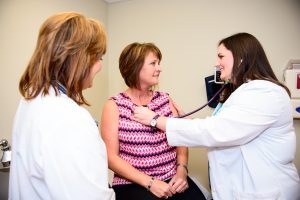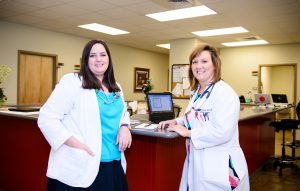
TUSCALOOSA, Ala. — Third-year medical students at The University of Alabama have an opportunity to follow a patient over time through the health care system as part of an innovative new program being piloted this year.
The Tuscaloosa Longitudinal Community Curriculum, or TLC2, is a program through UA’s College of Community Health Sciences that covers medical students’ third-year curriculum.
Third-year medical students learn about pediatrics, internal medicine, surgery, family medicine, psychiatry, neurology and obstetrics/gynecology by working with physicians in clinic settings. The traditional rotation schedule consists of seven eight-week rotations through the various specialties, but through TLC2, students spend most of their third-year working with a community physician and following patients throughout the diagnosis or disease.
For example, a student may gain competency in obstetrics during a patient’s visit to her OB/GYN, help deliver the baby, then follow the newborn through well-baby checks or they might see an adult patient at an initial visit, accompany them to specialty consults, assist in surgery on the patient then see the patient back in the primary care doctor’s office for follow-up visits, said Brook Hubner, CCHS program director of medical education.
“Many of the patients we treat, especially in Alabama, have multiple chronic diseases for which they need treatment,” said Kay Rainey, a third-year medical student at UA who is participating in the pilot program and currently working in Dr. Vernon Scott’s practice in Tuscaloosa.
“With that comes the need to see multiple specialists, and patients are required to navigate between all of the specialists, receiving different medications and instructions from each one,” Rainey said. “I think that this new integrated curriculum will make a lasting impression on me about how patients and our health care system interact, as a whole. I see it as an opportunity to see more of ‘the big picture’ of health care.”

While longitudinally integrated clerkships have been part of medical education for some time, medical schools are beginning to create these programs as evidence of their effectiveness and benefits accumulates. Medical students who have participated in these clerkships say they feel better prepared to care for patients, and studies show that the students perceive better clinical education and access to patients.
The length of the experience also allows time for students to become involved in the community, complete a community scholarly project, develop trusting and respectful relationships as a team member with physicians, clinic and hospital staff and patients, learn about the business of providing health-care services and appreciate the rewards and challenges of primary care.
“We encourage students to become involved in the community by attending ball games, religious services and otherwise becoming part of the town in which they are living,” Hubner said. “In other areas of the country where similar programs have been in place for years, communities view the student experience as a recruiting opportunity to attract physicians to the area.”
The biggest thing Elizabeth Junkin has learned from her experience with the program is the “art of communicating with the patients.”
“From convincing a patient to stop smoking to telling a family that their daughter is not going to wake up, there is an art to how to get your point across to a patient while providing the support they need to accept the news or make a change,” said the third-year medical student who is working at Dr. Julia Boothe’s practice in Reform. “A lot of this art comes with experience, but it also comes with truly knowing your patients. My hope is that I will be able to develop my own art of communication through the long-term personal relationships that I will develop with my patients in the TLC2 program.”
The College’s TLC2 will have other special curriculum components in primary care leadership, community engagement and population health that will be delivered through onsite and teleconferenced seminars throughout the nine-month experience. Admission to TLC2 is through a competitive selection process and limited to six students in the first year. After piloting the curriculum for a few years, the College would like to admit a full cohort of students who would participate in a longitudinally integrated curriculum, Hubner said.
“We know that this type of program will prepare future physicians with vigorous general professional clinical training,” said Dr. Richard Streiffer, dean of UA’s College of Community Health Sciences.
Contact
Kim Eaton, UA Media relations, 808/640-5912, kkeaton@ur.ua.edu